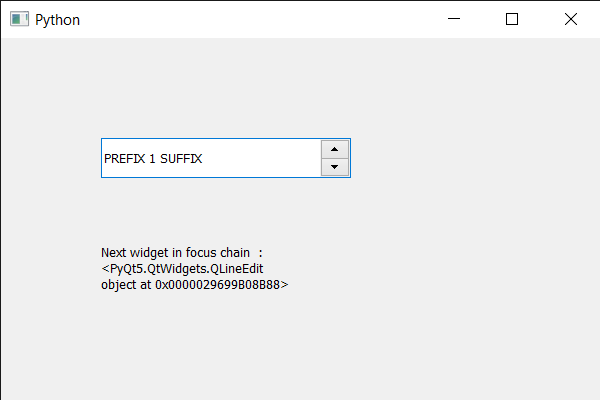En este artículo, veremos cómo podemos obtener el siguiente widget de string de enfoque del cuadro de número. El cuadro giratorio consta de dos widgets secundarios, uno es la edición de línea y el otro son los botones de flecha. El enfoque se establece widget por widget, es decir, la string de enfoque, por lo tanto, cuando el cuadro giratorio se enfoca, su hijo recibe el foco antes que el otro hijo.
Para hacer esto, usamos nextInFocusChainel método con el objeto de cuadro de número.
Sintaxis: spin_box.nextInFocusChain()
Argumento: no requiere argumento
Retorno: Devuelve el objeto QWidget
A continuación se muestra la implementación.
# importing libraries
from PyQt5.QtWidgets import *
from PyQt5 import QtCore, QtGui
from PyQt5.QtGui import *
from PyQt5.QtCore import *
import sys
class Window(QMainWindow):
def __init__(self):
super().__init__()
# setting title
self.setWindowTitle("Python ")
# setting geometry
self.setGeometry(100, 100, 600, 400)
# calling method
self.UiComponents()
# showing all the widgets
self.show()
# method for widgets
def UiComponents(self):
# creating spin box
self.spin = QSpinBox(self)
# setting geometry to spin box
self.spin.setGeometry(100, 100, 250, 40)
# setting range to the spin box
self.spin.setRange(1, 999999)
# setting prefix to spin
self.spin.setPrefix("PREFIX ")
# setting suffix to spin
self.spin.setSuffix(" SUFFIX")
# creating a label
label = QLabel(self)
# making the label multi line
label.setWordWrap(True)
# setting geometry to the label
label.setGeometry(100, 200, 200, 60)
# getting next in focus chain widget
value = self.spin.nextInFocusChain()
# setting text to the label
label.setText("Next widget in focus chain : " + str(value))
# create pyqt5 app
App = QApplication(sys.argv)
# create the instance of our Window
window = Window()
# start the app
sys.exit(App.exec())
Producción :
Publicación traducida automáticamente
Artículo escrito por rakshitarora y traducido por Barcelona Geeks. The original can be accessed here. Licence: CCBY-SA